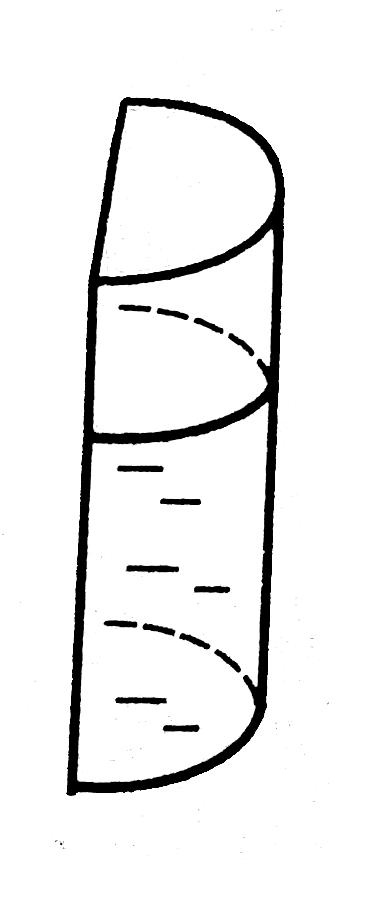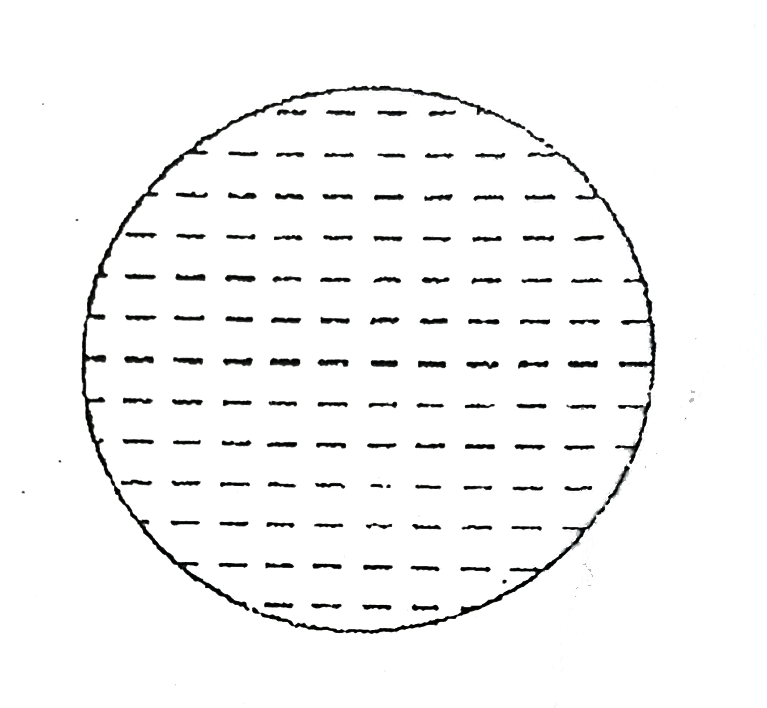A uniform vertical tube of circular cross section contains a liquid. The contact angle is 90∘. Consider a diameter of the tube lying in the surface of the liquid. The surface of the right of this diameter pulls the surface on the left of it. What keeps the surface on the left in equilibrium?
To solve the problem, we need to analyze the forces acting on the liquid surface in the tube and how they contribute to the equilibrium of the liquid surface on the left side of the diameter.
1. Understand the Setup:
- We have a vertical tube with a circular cross-section containing a liquid.
- The contact angle at the surface of the liquid is 90∘.
- We consider a diameter (let's call it AB) lying on the surface of the liquid.
2. Identify the Forces:
- The surface tension of the liquid acts along the surface of the liquid.
- The surface tension creates a force that acts tangentially along the surface of the liquid.
- The liquid surface on the right side of the diameter (AB) pulls the surface on the left side due to surface tension.
3. Analyze the Forces on Each Side:
- Let F be the force due to surface tension acting on the right side of the diameter.
- This force F pulls the liquid surface on the left side of the diameter towards the right.
- The semicircular walls of the tube also exert a force on the left side of the diameter due to the contact with the liquid.
4. Equilibrium Condition:
- For the surface on the left side of the diameter to be in equilibrium, the net force acting on it must be zero.
- The force pulling the left side towards the right (due to surface tension on the right side) must be balanced by an equal and opposite force acting on the left side.
5. Conclusion:
- The left surface remains in equilibrium because the forces acting on it are equal and opposite. The surface tension on the right side pulls the left side, while the contact force from the semicircular wall of the tube counteracts this pull.
- Since the contact angle is 90∘, the forces are balanced, and thus the left surface remains stable.
Final Answer:
The surface on the left remains in equilibrium due to the balance of forces from surface tension on the right side and the contact forces exerted by the tube walls.
---
- We have a vertical tube with a circular cross-section containing a liquid.
- The contact angle at the surface of the liquid is 90∘.
- We consider a diameter (let's call it AB) lying on the surface of the liquid.
- The surface tension of the liquid acts along the surface of the liquid.
- The surface tension creates a force that acts tangentially along the surface of the liquid.
- The liquid surface on the right side of the diameter (AB) pulls the surface on the left side due to surface tension.
- Let F be the force due to surface tension acting on the right side of the diameter.
- This force F pulls the liquid surface on the left side of the diameter towards the right.
- The semicircular walls of the tube also exert a force on the left side of the diameter due to the contact with the liquid.
- For the surface on the left side of the diameter to be in equilibrium, the net force acting on it must be zero.
- The force pulling the left side towards the right (due to surface tension on the right side) must be balanced by an equal and opposite force acting on the left side.
- The left surface remains in equilibrium because the forces acting on it are equal and opposite. The surface tension on the right side pulls the left side, while the contact force from the semicircular wall of the tube counteracts this pull.
- Since the contact angle is 90∘, the forces are balanced, and thus the left surface remains stable.
The surface on the left remains in equilibrium due to the balance of forces from surface tension on the right side and the contact forces exerted by the tube walls.
Topper's Solved these Questions
- SOME MECHANICAL PROPERTIES OF MATTERBOOK - HC VERMA ENGLISHCHAPTER - SOME MECHANICAL PROPERTIES OF MATTEREXERCISE - Objective-1
29 Videos
- SOME MECHANICAL PROPERTIES OF MATTERBOOK - HC VERMA ENGLISHCHAPTER - SOME MECHANICAL PROPERTIES OF MATTEREXERCISE - Objective-2
7 Videos
- SOME MECHANICAL PROPERTIES OF MATTERBOOK - HC VERMA ENGLISHCHAPTER - SOME MECHANICAL PROPERTIES OF MATTEREXERCISE - Exercises
32 Videos
- SIMPLE HARMONIC MOTIONBOOK - HC VERMA ENGLISHCHAPTER - SIMPLE HARMONIC MOTIONEXERCISE - Question for short Answer
15 Videos
- SOUND WAVESBOOK - HC VERMA ENGLISHCHAPTER - SOUND WAVESEXERCISE - All Questions
133 Videos
Similar Questions
A liquid is kept in a beaker of radius 4 cm. Consider a diameter of the beaker on the surface of the water. Find the force by which the surface on one side of the diameter pulls the surface on the other side. Surface tension of liquid =0.075Nm−1
View SolutionWater is kept in a beaker of radius 5.0 cm. Consider a diameter of the beaker on the surface of the water. Find the force by which the surface on one side of the diameter pulls the surface on the other side. Surface tension of water =0.075Nm−1.
View Solution
Knowledge Check
A liquid will not wet the surface of a solid if the angle of contact is
AzeroBequal to45∘Cequal to90∘Dgreater than 90∘
A liquid is contain in a vertical tube of semicircular cross section figure. The contact angle is zero. The force of surface tension on the curved part and on the flat part are in ratio

View SolutionIn the glass capillary tube, the shape of the surface of the liquid depends upon
View Solution
Consider a bubble of soap solution. Find the surface tension force between the left half surface and right half surface
View SolutionA liquid will not wet the surface of a solid if the angle of contact is
View SolutionEscape of the more energetic molecules from the surface of a liquid decreases the average temperature of the molecules that are left behind.
View SolutionConsider the water drop of radius R. Find surface tension force between the left half surface and right half surface ?

View SolutionA liquid of diameter D breaks up into 64 tiny drops. If the surface tension of the liquid is σ what is the change in energy?
View Solution
